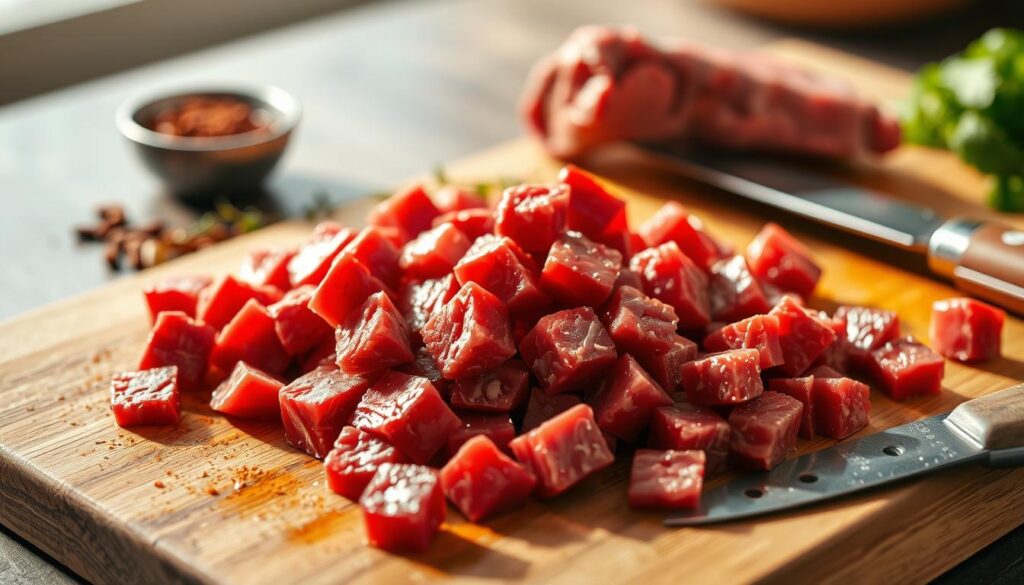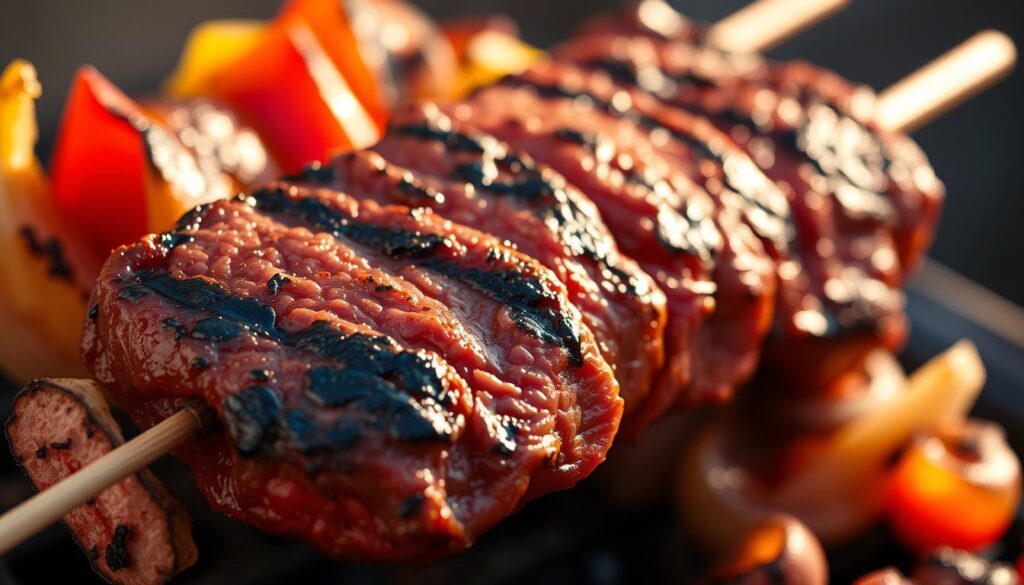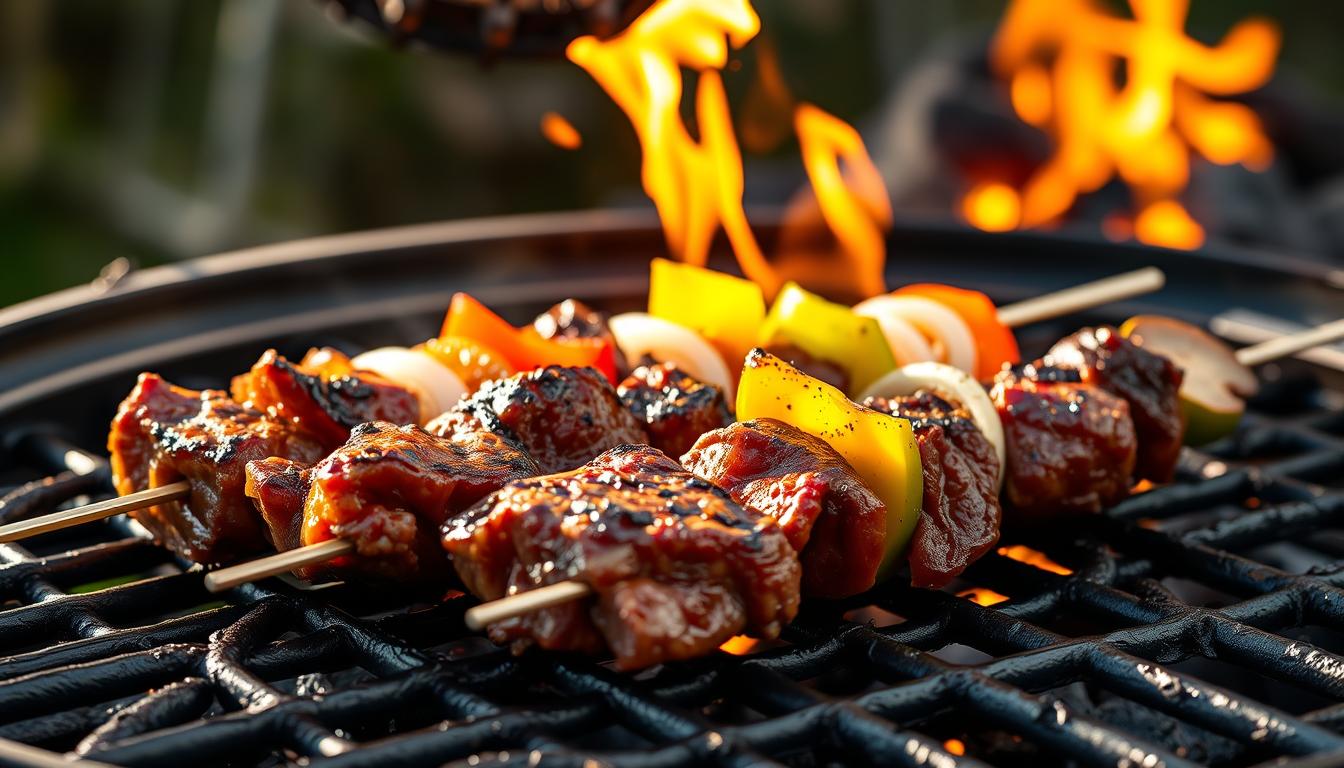Summer evenings remind us of sizzling grills and the smell of steak kebabs. Every time I grill, I think of family gatherings. Those were the times when perfectly charred skewers were the main dish.
Making the best steak kebab is more than just putting meat on a stick. It’s an art that needs technique, passion, and secrets. Whether you’re new to grilling or a pro, learning to make perfect steak kebabs can take your cooking to the next level.
In this guide, we’ll explore the world of delicious steak kebabs. You’ll learn five key tips to make your skewers amazing. From choosing the right meat to getting that perfect char, we’ll cover every step. You’ll make kebabs that everyone will love.
Get ready to learn how to make top-notch steak kebabs in your backyard. These tips will make sure your skewers are always juicy, tender, and full of flavor.
Understanding the History and Origins of Shish Kebabs
Shish kebabs have a long history that spans centuries and continents. Your homemade steak kebab recipe connects you to a rich tradition from the Middle East. These tasty skewered dishes have grown from simple street food to a global favorite.
The story of kebabs starts in ancient Turkey and the Middle East. Nomadic warriors used their swords to grill meat over fires. This simple method turned into a beloved cooking technique around the world.
Culinary Roots in Middle Eastern Cuisine
Traditional kebab making involves choosing the right meats and cooking techniques. Today’s easy steak kebab recipe shows the wisdom of generations. It’s a blend of family and cultural traditions.
- Originated in Turkish and Persian cultures
- Initially prepared with lamb and goat meat
- Cooking method developed for preservation and portability
Global Kebab Evolution
Trade routes and cultural mixing led to kebabs’ evolution. Each place added its own twist, using local tastes and ingredients. This created a variety of kebabs that show off local creativity.
| Region | Kebab Variation | Unique Characteristics |
|---|---|---|
| Middle East | Classic Shish Kebab | Lamb-based, heavy spices |
| Greece | Souvlaki | Pork or chicken, oregano-seasoned |
| India | Seekh Kebab | Minced meat, intense spice blend |
Cultural Significance
Making a homemade steak kebab today is more than cooking. It’s about connecting with a deep culinary heritage. From Istanbul’s street vendors to American backyard grills, kebabs bring people together through food.
Selecting the Perfect Cut of Beef for Steak Kebab
Creating tasty grilled steak kebabs begins with picking the right beef. The meat you choose greatly affects the kebab’s taste and texture. Not all beef cuts are the same when it comes to making tender, flavorful kebabs.
For the best results, choose these top beef cuts:
- Top Sirloin: Offers a great mix of tenderness and beef flavor
- Sirloin Tips: Lean but juicy, ideal for kebab skewers
- New York Strip: Rich in marbling and taste
- Ribeye: Rich for those who love meat
When picking beef for your kebabs, keep these tips in mind:
- Choose meat with little connective tissue
- Go for cuts with a bit of marbling for more flavor
- Buy fresh, high-quality beef from trusted butchers
- Get meat cut into 1-inch cubes for even cooking
Professional chefs say to spend on premium beef cuts. They might be pricier, but your kebabs will taste and feel much better. Remember, the best kebabs start with the best meat.
“The quality of your ingredients defines the success of your dish” – Culinary Wisdom
Essential Equipment and Tools for Kebab Making
Making a juicy steak kebab is more than just using good ingredients. The right tools can make your grilling better and make your steak kebab amazing.
Choosing the right tools is key for a great kebab. Your tools can affect everything from how you prepare the meat to how it looks when it’s done.
Skewer Selection: Metal vs. Wooden Options
When picking skewers for your juicy steak kebab, think about these important points:
- Flat metal skewers stop meat from spinning
- Stainless steel skewers are tough and can be used again
- Wooden skewers need soaking before use to avoid burning
Grill Types for Perfect Temperature Control
Each grill type has its own benefits for making a flavorful steak kebab:
- Charcoal grills give a real smoky taste
- Gas grills keep the temperature steady
- Electric grills are perfect for cooking inside
Must-Have Kebab Accessories
These tools will make your kebab-making better:
- Meat thermometer for exact doneness
- Heavy-duty grill tongs
- Marinade brushes
- Aluminum foil for resting meat
Good equipment means your steak kebabs will always be tender, juicy, and full of flavor.
The Ultimate Steak Kebab Marinade Recipe
Making a tasty steak kebab begins with a great marinade. It turns regular meat into a culinary masterpiece. A good marinade tenderizes and boosts the meat’s natural taste.
The best marinade for steak kebabs has several key parts. These parts mix to give a rich, complex flavor. Your marinade should include:
- 1/4 cup Worcestershire sauce
- 3 tablespoons soy sauce
- 2 tablespoons fresh lemon juice
- 2 teaspoons Dijon mustard
- 3 minced garlic cloves
- 2 tablespoons olive oil
When marinating steak kebabs, timing is key. Aim for 2-4 hours to let the flavors soak in. Too long, and the meat gets mushy. Too short, and it misses out on flavor.
| Ingredient | Purpose | Flavor Impact |
|---|---|---|
| Worcestershire Sauce | Tenderize | Deep umami complexity |
| Soy Sauce | Salt and Season | Rich, savory undertones |
| Lemon Juice | Acidic Break Down | Bright, fresh notes |
| Garlic | Aromatic | Intense flavor booster |
For the best steak kebabs, marinate in a non-reactive container. Use glass or ceramic. Make sure the meat is fully covered. Refrigerate it to keep it safe and cool. Your hard work will pay off with a delicious kebab that’s full of flavor.
Best Vegetables to Pair with Steak Kebabs
Creating the perfect steak kebab is more than just the meat. The right vegetables can make your dish amazing. They add color, flavor, and nutrition, making your meal complete and delicious.
Choose vegetables that can handle high heat and match your steak’s flavor. Some great picks are:
- Red bell peppers – sweet and vibrant
- Red onions – adds sharp, caramelized notes
- Mushrooms – earthy and meaty texture
- Zucchini – light and tender
- Cherry tomatoes – burst with juicy freshness
Optimal Vegetable Cutting Techniques
Uniform cuts ensure even cooking and look great. Cut vegetables into 1-1.5 inch pieces. Pro tip: Cut vegetables slightly larger than meat chunks to prevent overcooking.
Complementary Flavor Combinations
Try different flavor pairings to boost your steak kebabs. Pairings like red onions with bell peppers or mushrooms with zucchini are exciting.
Vegetable Marinating Tips
Marinate vegetables separately from meat to avoid sogginess. Use light marinades with olive oil, herbs, and a bit of acid. This keeps vegetables crisp and flavorful.
Proper Meat Preparation and Cubing Techniques

Creating the perfect homemade steak kebab starts with precise meat preparation. The right cubing technique can transform an ordinary meal into a juicy steak kebab that will impress your guests.
When selecting your meat, choose high-quality beef cuts like sirloin or ribeye. These cuts provide the best flavor and tenderness for your kebabs. Look for meat with minimal fat marbling to ensure even cooking.
- Use a sharp chef’s knife for clean, precise cuts
- Trim excess fat before cubing
- Cut meat against the grain for maximum tenderness
The ideal cube size for a juicy steak kebab is approximately 1 1/2 inches. This specific dimension allows the meat to:
- Sear beautifully on the outside
- Retain moisture in the center
- Cook evenly throughout
Pro tip: Chill the meat for 15-20 minutes before cutting to make slicing more precise and easier.
Consistent cube size is crucial for uniform cooking. Take your time to create evenly sized pieces, which will help you achieve restaurant-quality homemade steak kebabs every time.
Mastering the Art of Kebab Assembly
Making the perfect grilled steak kebab is more than just throwing meat and veggies on a skewer. The art of kebab assembly is key to a flavorful steak kebab that looks and tastes great.
Your success in kebab-making depends on how you place ingredients and skewer them. The right way can turn a simple meal into a culinary masterpiece.
Spacing and Balance Tips
Achieving the perfect kebab is all about balance. Follow these key guidelines:
- Leave small gaps between ingredients to ensure even cooking
- Distribute weight evenly across the skewer
- Choose ingredients of similar size for consistent heat distribution
Order of Ingredients
The secret to a delicious grilled steak kebab is in the order of ingredients. Professional chefs suggest the following:
- Start with a piece of meat
- Add a vegetable with similar density
- Alternate between protein and vegetables
- End with a complementary ingredient
“The key to a perfect kebab is balance and variety in every bite.” – Grilling Experts
Pro tip: Use slightly larger pieces of meat between smaller vegetable chunks. This protects delicate veggies from heat while ensuring even cooking of your flavorful steak kebab.
By mastering these assembly techniques, you’ll create kebabs that are more than just a meal. They’ll be a culinary experience that wows everyone at your grill.
Grilling Temperature and Timing Guidelines
Grilling steak kebabs to perfection needs precision and heat control. Your marinated steak kebabs need careful attention. This ensures they are cooked just right without losing their juiciness.
For the best steak kebabs, manage your grill temperature and cooking time well. Aim for a medium-high heat of 400-450°F. This heat is perfect for searing your meat.
- Preheat your grill for 10-15 minutes before cooking
- Create direct and indirect heat zones
- Use an instant-read thermometer for accuracy
Grill your steak kebabs for about 3-4 minutes on each side. You want a nice char and a tender, medium-rare center. Aim for an internal temperature of 125-130°F for the best results.
“The difference between a good and great kebab is often just a matter of minutes on the grill.” – Grilling Expert
Different marinades can change cooking times. Sugary marinades can make your kebabs brown faster. So, keep an eye on them to avoid burning. Adjust your grilling based on your marinade.
Let your kebabs rest for 3-5 minutes after grilling. This lets the juices spread, making them more flavorful and tender.
How to Achieve the Perfect Char and Doneness

To make the best steak kebab, you need to master char and doneness. Your aim is to get a crispy outside and a juicy inside. This will wow everyone at the grill.
Getting the perfect char means knowing about temperature and visual signs. High heat is key for those tasty grill marks that make your steak kebab unforgettable.
Temperature Control Techniques
Here are the main temperature control methods for the best steak kebab:
- Preheat your grill to high heat (around 450-500°F)
- Create direct and indirect heat zones
- Use a two-stage grilling approach
- Allow brief resting periods between turning
Visual Indicators of Perfect Doneness
Learn to spot the signs of perfectly cooked steak kebabs:
- Color changes: From deep red to pink or light brown
- Surface texture: Crisp, slightly charred exterior
- Meat firmness: Soft but springy when pressed
Professional grill masters know timing and watching are crucial for delicious kebabs. With practice, you’ll get better at finding that perfect mix of char and tenderness in your steak kebab.
Storage and Leftover Management
After enjoying your homemade steak kebab, it’s important to store it right. This keeps the flavor and ensures food safety. Your easy steak kebab recipe can still delight you for days with the right storage.
First, refrigerate your kebabs. Here’s how to keep them fresh:
- Cool kebabs to room temperature within 2 hours of cooking
- Remove meat and vegetables from skewers
- Store in airtight containers
- Refrigerate for up to 4 days
Freezing is another way to keep your kebabs longer. Follow these steps for long-term storage:
- Unthread meat and vegetables from skewers
- Place in freezer-safe containers
- Seal tightly to prevent freezer burn
- Store for up to 3 months
When reheating, thaw in the fridge overnight. Heat gently to avoid drying out the meat. Turn leftovers into new dishes like salads, wraps, or stir-fries. This keeps your easy steak kebab recipe fresh and exciting.
Serving Suggestions and Side Dish Pairings
Make your flavorful steak kebab even better with the right side dishes. These dishes can turn a good meal into an amazing one. They add to the rich, grilled flavors, making your meal unforgettable.
Here are some classic and new ideas for serving your grilled steak kebabs:
Traditional Middle Eastern Accompaniments
- Rice Pilaf: A fluffy, aromatic base that absorbs the kebab’s delicious marinade
- Creamy Hummus: Provides a smooth contrast to the charred meat
- Fresh Tabbouleh: Adds a light, herbal touch to your flavorful steak kebab
- Warm Pita Bread: Perfect for soaking up extra juices
Modern Serving Innovations
Try new side dishes to add excitement to your grilled steak kebab:
- Quinoa salad with roasted vegetables
- Grilled corn with herb butter
- Mediterranean couscous
- Tangy cucumber and dill salad
Pro tip: Mix and match these sides to create a personalized dining experience. This shows off the versatility of your grilled steak kebabs.
Conclusion
Making the perfect juicy steak kebab is more than just cooking. It’s an art that mixes passion, skill, and flavor knowledge. You’ve learned key strategies to turn simple ingredients into amazing meals that wow everyone.
Your journey starts with choosing top-quality cuts, knowing how to marinate, and mastering grilling. The steak kebab you make shows your cooking talent and love for quality. Each skewer is a chance to try new flavors and cooking styles.
Whether you’re experienced or new to grilling, these tips will improve your kebab skills. Remember, the more you practice, the better you’ll get. Enjoy the journey of making these tasty skewers.
Your kebab adventure is just starting. Try new marinades, mix different veggies, and find your own grilling style. The world of steak kebabs is ready for your creativity.

